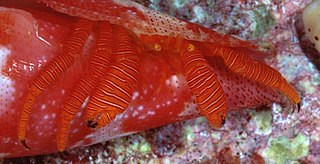
The Diogenidae are a family of hermit crabs, sometimes known as "left-handed hermit crabs" because in contrast to most other hermit crabs, its left chela (claw) is enlarged instead of the right. It comprises 429 extant species, and a further 46 extinct species, making it the second-largest family of marine hermit crabs, after the Paguridae.

Ciliopagurus is a genus of hermit crabs, of the family Diogenidae, which are sometimes referred to as the "left-handed hermit crabs", because in contrast to most other hermit crabs, the left chela (claw) is enlarged instead of the right. They are found in the Indo-Pacific region and in the eastern Atlantic Ocean.
Ciliopagurus albatrossi is a species of hermit crab native to the Hawaiian region.
Ciliopagurus alcocki is a species of hermit crab native to New Caledonia.
Ciliopagurus haigae is a species of hermit crab native to Tanzania.
Ciliopagurus liui is a species of hermit crab native to the Gulf of Tonkin and waters to the south of Japan.
Ciliopagurus macrolepis is a species of hermit crab native to Indonesia.
Ciliopagurus major is a species of hermit crab native to French Polynesia.

Ciliopagurus pacificus is a species of hermit crab native to French Polynesia.
Ciliopagurus plessisi is a species of hermit crab native to French Polynesia.
Ciliopagurus tricolor is a species of hermit crab native to Madagascar. It is one of four species in the "strigatus complex", having morphological similarities to C. strigatus, with the most prominent variance being coloration.
Ciliopagurus caparti is a species of hermit crab native to South East Atlantic.

Ciliopagurus galzini is a species of hermit crab. It is one of four species in the "strigatus complex"; it resembles C. strigatus, with the most prominent difference being coloration. It is common in the shallow intertidal waters of the Tuamotus.
Ciliopagurus hawaiiensis is a species of hermit crab native to Hawaii.
Ciliopagurus krempfi is a species of hermit crab from the Indo-Pacific.
Ciliopagurus obesus is a fossil species of hermit crab, described from Rupelian (Oligocene) sediments at Sint-Niklaas, Belgium.
Ciliopagurus shebae is a species of hermit crab native to Madagascar, the Red Sea, Réunion, the Seychelles, and the West Indian Ocean.
Ciliopagurus substriatiformis was a species of hermit crab that existed during the Badenian stage.
Ciliopagurus tenebrarum is a species of hermit crab native to Cape Comorin.
Ciliopagurus vakovako is a species of hermit crab native to the Marquesas Islands. It is typically found at a depth no lower than 57 metres (187 ft). C. vakovako appears to be a vicariant of C. strigatus, a species widespread throughout the Indo-pacific region.



